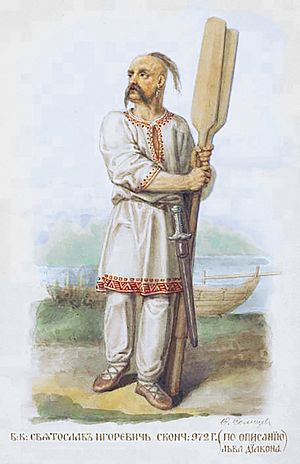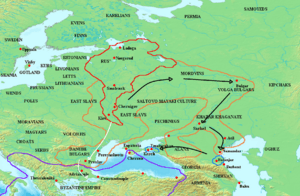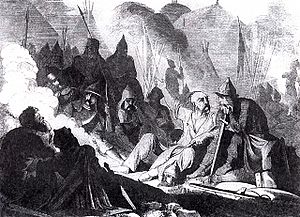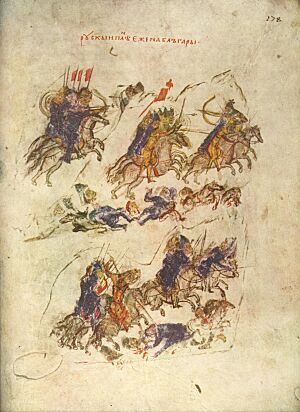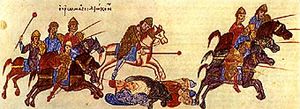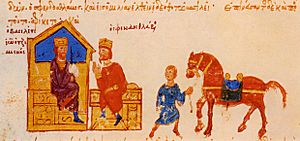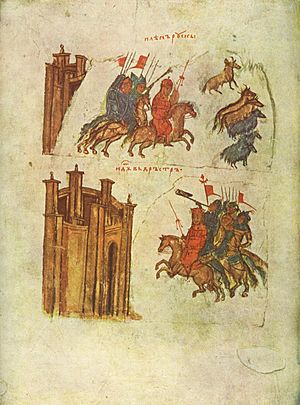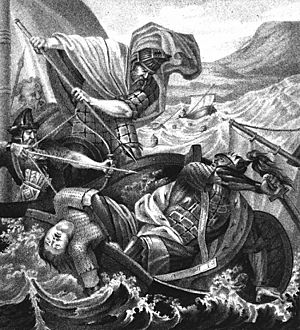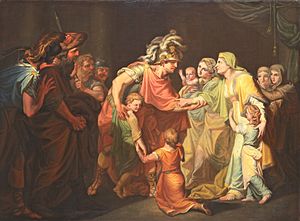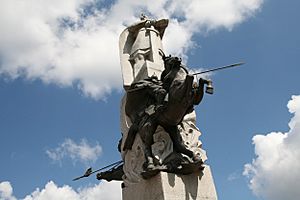Sviatoslav I facts for kids
Quick facts for kids Sviatoslav the Brave |
|
|---|---|
| Grand Prince of Kiev | |
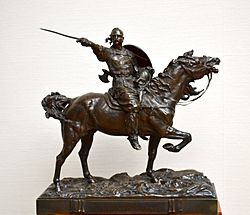
Sviatoslav I by Eugene Lanceray (1886)
|
|
| Reign | 945–972 |
| Coronation | 964 |
| Predecessor | Olga of Kiev |
| Successor | Yaropolk I |
| Born | March 943 Kiev, Kievan Rus' |
| Died | 26 March 972 (aged 28–29) The island of Khortytsia, Dnieper |
| Wives |
|
| Issue | Yaropolk I Oleg Vladimir the Great Sfengus (possibly) |
| Dynasty | Rurikid |
| Father | Igor of Kiev |
| Mother | Olga of Kiev (regent 945–964) |
| Religion | Slavic paganism |
Sviatoslav I Igorevich (born 943 – died March 26, 972) was a powerful ruler of Kievan Rus'. He was known as the Grand Prince of Kiev and was famous for his many military campaigns. His actions led to the fall of two major powers in Eastern Europe: Khazaria and the First Bulgarian Empire.
Sviatoslav conquered many East Slavic tribes and defeated the Alans. He also attacked the Volga Bulgars. Sometimes, he even teamed up with the Pechenegs and Magyars (Hungarians). His rule, though short, saw the Kievan Rus' expand greatly. By the end of his life, Sviatoslav had created one of the largest states in Europe. In 969, he even moved his capital from Kiev to Pereyaslavets on the Danube River.
Unlike his mother, Olga of Kiev, Sviatoslav chose to remain a pagan throughout his life. His sudden death in an ambush meant that his many conquests were not fully secured. Also, he didn't set up a clear plan for who would rule next. This led to a conflict among his three sons, where two of them were killed.
Contents
Who Was Sviatoslav?
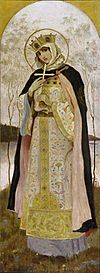
Sviatoslav was the first ruler of Kievan Rus' with a name that came from Slavic origins. His name combines the Slavic words for "holy" and "glory." Before him, rulers had names from Old Norse (like the Vikings). Some experts think his name was created by combining parts of his ancestors' names.
The Greek writer Leo the Deacon described Sviatoslav very clearly. He met Sviatoslav and said he was a strong man of average height with bright eyes. He had a bald head, a thin beard, and a bushy mustache. He also wore a sidelock, which was a sign of his royal status. Sviatoslav liked to dress in white, and his clothes were always cleaner than his soldiers'. He wore a large gold earring with a red gem and two pearls.
Early Life and Family
We don't know much about Sviatoslav's early years. He spent his childhood in Novgorod. His father, Igor, was killed by the Drevlians around 945. After Igor's death, Sviatoslav's mother, Olga, ruled as a regent (someone who rules for a young king) in Kiev. She ruled until Sviatoslav was old enough to take over, around 963.
Sviatoslav was taught by a Varangian (a Viking) named Asmud. This was a common practice for princes at the time. Sviatoslav wasn't very interested in running the government. He preferred to spend his life with his druzhina (his group of loyal warriors) fighting wars against neighboring states.
According to old stories, Sviatoslav traveled light during his campaigns. He didn't carry wagons or cooking pots. He didn't even boil meat. Instead, he would cut small pieces of horse meat, game, or beef and roast them over coals. He didn't use a tent, sleeping on a horse-blanket with his saddle as a pillow, just like his warriors.
Sviatoslav had several children, but the stories don't say much about his wives. He had two sons, Yaropolk and Oleg, with one wife. He had another son, Vladimir, with a woman named Malusha. Vladimir later became a very important ruler who brought Christianity to Rus'.
Sviatoslav's Children
- Oleg of Drelinia (died 977?)
- Yaropolk I of Kiev (952–978)
- Vladimir the Great (c. 958 – 1015)
- Sfengus (possibly)
Religious Beliefs
Sviatoslav's mother, Olga, became a Christian in 957. But Sviatoslav chose to remain a pagan his whole life. In a treaty with the Byzantine emperor in 971, the Rus' warriors swore by the pagan gods Perun and Veles.
Old stories say that Sviatoslav believed his warriors would lose respect for him if he became a Christian. He needed their loyalty to build his large empire, which stretched from the Volga River to the Danube River.
Military Campaigns and Expansion
Soon after becoming ruler, Sviatoslav began to expand Rus' control. He focused on the Volga River valley and the Pontic steppe region. His biggest achievement was conquering Khazaria, which had been a very strong state in Eastern Europe for centuries.
Historians believe the Rus' wanted to control the Volga trade route, which the Khazars had taxed. The Byzantine Empire might have also encouraged the Rus' to fight the Khazars.
Sviatoslav first gathered the East Slavic tribes who were under Khazar rule. Those who didn't join him, like the Vyatichs, were attacked and forced to pay tribute to Kievan Rus' instead of the Khazars. A famous story says Sviatoslav sent a message to the Vyatich rulers: "I want to come at you!" This phrase is still used today to mean a clear declaration of intentions.
He then moved along the Oka and Volga rivers and attacked Volga Bulgaria. Sviatoslav used Oghuz and Pecheneg fighters in this campaign. This was likely to counter the strong cavalry (horse soldiers) of the Khazars and Bulgars.
Sviatoslav destroyed the Khazar city of Sarkel around 965. He also likely attacked Kerch in Crimea. At Sarkel, he set up a Rus' settlement called Belaya Vyezha, meaning "the white tower." He then destroyed the Khazar capital of Atil. A visitor wrote that after Sviatoslav's attack, "no grape or raisin remained, not a leaf on a branch."
Even though Sviatoslav attacked many Khazar cities, he didn't stay to rule the Khazar lands permanently. On his way back to Kiev, he attacked the Ossetians and made them submit. The destruction of Khazar power allowed Kievan Rus' to control important trade routes. These routes went through the steppe and across the Black Sea. Sviatoslav's campaigns also led to more Slavic people settling in the region.
Campaigns in the Balkans
The destruction of Khazaria happened while Rus' and the Byzantine Empire were allies. In 967 or 968, the Byzantine Emperor Nikephoros Phokas asked Sviatoslav for help. He wanted Sviatoslav to fight against Bulgaria. Sviatoslav was paid a large amount of gold and set sail with an army of 60,000 men, including Pecheneg fighters.
Sviatoslav defeated the Bulgarian ruler Boris II and took control of northern Bulgaria. Meanwhile, the Byzantines paid the Pechenegs to attack Kiev, where Sviatoslav's mother Olga and his son Vladimir were staying. The siege was lifted, and Olga sent a letter to Sviatoslav, telling him to return. He quickly came back and defeated the Pechenegs.
Sviatoslav refused to give his Balkan conquests to the Byzantines, and the alliance broke down. Sviatoslav decided to move his capital to Pereyaslavets at the mouth of the Danube River. He believed it was a great place for trade. He explained that "all the riches flow" there: gold, silks, wine, and fruits from Greece; silver and horses from Hungary and Bohemia; and furs, wax, honey, and slaves from Rus'.
In the summer of 969, Sviatoslav left Rus' again. He divided his lands among his three sons. With an army that included Pecheneg and Magyar soldiers, he invaded Bulgaria again. He attacked Thrace, captured Philippopolis, and killed many of its people. The Byzantine Emperor Nikephoros was then overthrown and killed by John Tzimiskes, who became the new emperor.
John Tzimiskes tried to convince Sviatoslav to leave Bulgaria, but Sviatoslav refused. Sviatoslav then crossed the Danube and attacked Adrianople, causing panic in Constantinople. Later that year, the Byzantines fought back. John Tzimiskes sent his commander, Bardas Skleros, who defeated the combined forces of Rus', Pechenegs, Magyars, and Bulgarians.
Sviatoslav retreated to Dorostolon, which the Byzantine armies besieged for 65 days. Trapped, Sviatoslav made a deal with John Tzimiskes. He agreed to leave the Balkans, give up his claims to southern Crimea, and return west of the Dnieper River. In return, the Byzantine emperor gave the Rus' food and safe passage home. Sviatoslav and his men sailed to Berezan Island at the mouth of the Dnieper. They camped there for the winter, but a famine hit their camp. Sviatoslav's campaign didn't bring lasting gains for Rus', but it weakened Bulgaria.
Death and What Happened Next
The Byzantine emperor feared that the peace with Sviatoslav wouldn't last. So, he convinced the Pecheneg leader Kurya to kill Sviatoslav before he reached Kiev. This was part of a plan to keep the Rus' and Pechenegs fighting each other.
According to old Slavic stories, Sviatoslav was warned to avoid the Dnieper rapids. But he ignored the advice and was ambushed and killed by the Pechenegs in early 972. This happened when he tried to cross the rapids near Khortytsia. The stories say that the Pecheneg leader made Sviatoslav's skull into a drinking cup.
After Sviatoslav's death, his sons began to fight among themselves. A war broke out between his sons Oleg and Yaropolk in 976, and Oleg was killed. In 977, Vladimir fled to Scandinavia. He gathered an army of Varangians and returned in 980. Yaropolk was killed, and Vladimir became the sole ruler of Kievan Rus'.
Sviatoslav in Art and Stories
Sviatoslav has long been seen as a hero in Belarusian, Russian, and Ukrainian history because of his military successes. Russian artists and poets became interested in him during the Russo-Turkish War (1768–1774). His push towards Constantinople seemed to connect with Russia's own expansion south.
Many artworks and poems were created about him. For example, Ivan Akimov's painting Sviatoslav's Return from the Danube to Kiev (1773) shows the conflict between a warrior's duty and his family. In the 19th century, interest in Sviatoslav grew even more. Klavdiy Lebedev painted a famous scene of Sviatoslav meeting Emperor John Tzimiskes. Eugene Lanceray created an equestrian statue of Sviatoslav.
Sviatoslav is also a character in books and films. He is the main character in the books Knyaz and The Hero by Russian writer Alexander Mazin. He also appears in the Soviet film The Legend of Princess Olga, which tells his mother's story.
In 2011, a Ukrainian fisherman found a one-meter-long sword in the Dnieper River near Khortytsia. This is where Sviatoslav is believed to have been killed. The sword's handle is made of gold and silver. Some people think it might have belonged to Sviatoslav himself, but this is just a guess.
Legacy
Today, Sviatoslav is remembered in Ukraine. Some cities have streets named after him, such as Svyatoslav the Brave Street or Prince Svyatoslav Street.
Images for kids
-
Sviatoslav's mother, Olga, with her escort in Constantinople, from an 11th-century chronicle.
See also
 In Spanish: Sviatoslav I de Kiev para niños
In Spanish: Sviatoslav I de Kiev para niños


